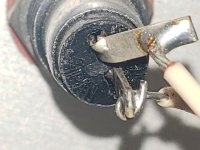Now that I've had a little time to stop feeling sorry for myself.... Good find!!!
I've never, ever, seen the old Raytheon keyboard switches anywhere, other than on a Kenbak-1. A google search turns up an bulletin board referencing a keyboard that may have used them, but the link to the ebay listing is long gone. An advertisement I saw in
November 1969 Electronics magazine shows Raytheon was actively trying to market these switches, but I suspect they were just too deep (long) for designers to want them. A keyboard using them would be too thick to comfortably sit on a desk and type on. That's a fatal flaw. I always suspected John Blankenbaker found a great low price for them somewhere in 1971, but I've searched various well known catalogs (Allied Electronics, etc.) and never been able to find anyone selling them. They were not ideal for the Kenbak-1, as they were designed to be soldered into a PC board, not mounted on a panel (hence, the problematic glue mounting required.)
Funny, I was always perplexed by these odd switches until I finally found information about them in the Electronics magazine advertisement. I originally suspected they could be "mercury wetted switches" where a drop of mercury on a contact was used to eliminate switch bounce. I had heard such things were made in the mid-sixties, but never ran into any examples. Debounce circuitry won out.
Anyway, Good find. I'm glad I didn't find it first. I see what the seller originally wanted. $29 each. I tend to collect too much of this "unobtanium" and will never complete half of the projects I'd like to. Yea, that's right. I'm glad I didn't find it. Yea. That's right. That's what I need to keep telling myself.
- Thomas.










